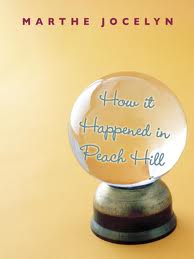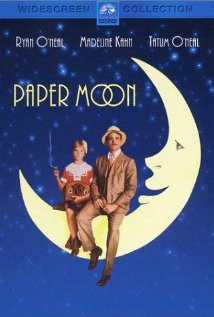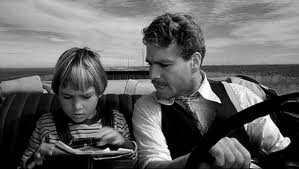Glen Huser’s Movie and Book Picks for November, 2011
 My Book Pick: How It Happened in Peach Hill
My Book Pick: How It Happened in Peach Hill
The Young Adult Book Club I belong to here in Vancouver is reading two novels by Marthe Jocelyn for our early December get-together – Would You (Tundra, 2008) and How It Happened at Peach Hill (Tundra, 2007). Both are excellent reads. For Would You, the story of a teenage girl whose older sister is in a coma following a road accident, you will need to keep a box of Kleenex close at hand.
How It Happened in Peach Hill – my book pick for this month – is also the story of a teenage girl with a problem. In this case, though, the problem is her mother – a self-centered con artist who knows how to whip up a great séance, complete with bells and other special effects, or conduct a public forum featuring her expertise as a mind-reader. The only tissues you might need while reading this novel, would be to dab away a tear or two if you end up laughing too hard.
On the run from their last stint of fleecing the public, Annie and her mother land in the small town of Peach Hill, where Mom comes up with the ruse of having her daughter appear to be a slobbering, cross-eyed idiot. This allows Annie to eavesdrop wherever she wanders, and to report back tidbits of information invaluable for reading palms or conducting visitations with the dead. But Annie decides to take her fate into her own hands when she sees the boy of her dreams – on a daily path to school that takes him past her yard – and orchestrates a miraculous recovery from her idiocy. Sammy Sloane is duly impressed and his interest in Annie grows as she seizes opportunities to display her own prowess as a clairvoyant. She has Mom’s tricks up her sleeve – and a few of her own.
Into the mix of all this, Jocelyn introduces a cast of great supporting characters including a barefoot, back-alley thief, the daughter of a revivalist preacher peddling booze as a spiritual elixir; a no-nonsense truant officer; and a housemaid who, while easily hoodwinked, has the true instincts of a nurturing mother – instincts that are sparse indeed in Annie’s actual parent.
I was reminded of Richard Peck’s novels featuring Blossom Culp, a teenager from the early years of the 20th century who actually does have the gift of second sight. Peck introduced Blossom in The Ghost Belonged to Me, back in 1976, beginning a series that focused on the adventures of the irrepressible clairvoyant over the course of four novels. Like It Happened in Peach Hill, Peck’s novels are a great deal of fun – and I love the fact that they offer today’s young readers glimpses of a world back in the days when their great-grandparents lived (something I’ve attempted to do with my most recent young adult novel, The Runaway).
My Movie Pick: Paper Moon
Another novel I couldn’t help thinking about as I read How It Happened in Peach Hill was Joe David Brown’s Addie Pray (Simon & Schuster, 1971; republished as Paper Moon, Thunder’s Mouth Press, 2002), which I picked up some thirty years ago and fell in love with. Peter Bogdanovich filmed the novel, retitling it Paper Moon, in 1973 – and the movie, my pick for this month, is one that I think will prove ageless in its appeal. I would be hard pressed to count the number of times I’ve watched it.
Set in the dustiest days of the Great Depression, the story recounts the adventures of nine-year-old Addie Loggins (Tatum O’Neal) who, after the death of her mother, hooks up with a con artist – Moses Pray (Ryan O’Neal) — she is convinced is her father (after all, people say she “has his jaw”) although he adamantly denies the relationship. Pray accepts two hundred dollars from the man who caused the death of Addie’s mother in a car accident, money in trust for the little girl along with a commission for delivering her to the home of her aunt.
The journey barely underway, Moze manages to run through the money and ends up resorting to scams that have served him well – such as selling Bibles at greatly inflated prices to recently-widowed women and hoodwinking slow-witted farmers into trusting him with their bankrolls. When Addie reveals herself to be a quick learner and a valuable adjunct in the scams, any urgency to get her to her aunt’s disappears. Riding high, Moses adds to their entourage a stripper, Trixie Delight (Madeline Kahn) and her African American maid (P. J. Johnson), but Addie – seeing their hard-won winnings disappearing – engineers a plan for getting rid of the two.
Paper Moon is probably Bogdanovish’s best movie following his classic The Last Picture Show. The picture was filmed on location in Kansas and Missouri in black and white by master cinematographer Laszlo Kovacs, who used special filters to capture the feel of rural America during the dirty thirties. But the picture really rides on the slim shoulders of Tatum O’Neal, who takes on the mantle of the tough-as-nails Addie as if it had been cut for no one but her. Tatum won the best supporting actress Academy Award – the youngest performer to ever take the prize (interestingly she’s on screen for pretty well the entire picture – making one wonder about the criteria for ‘supporting’). Madeline Kahn was in contention for the same award (and she is very good as the carnival dancer who manages to captivate Moses Pray). Ryan O’Neal is in top form too in a cast that is bolstered by characters Bogdanovich seems to have plucked out of the backwaters of the Midwest.
The sound track is pretty well made up of music from the 30’s – something that I, as a fan of music of the period, found a special pleasure. We get to hear Ozzie Nelson’s “About a Quarter to Nine”, the Boswell sisters singing “I Found a Million Dollar Baby,” Hoagy Carmichael tinkling the ivories with “Georgia on My Mind”….to mention a few of the pieces. And then, of course there’s the title tune, “Paper Moon.” When Bogdanovich (who didn’t care for the book’s title) was running possible alternate titles by his friend Orson Welles, the aging director responded by saying, “That title is so good, you shouldn’t even make the picture. Just release the title.”

